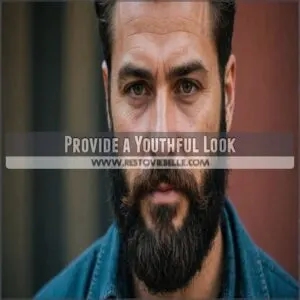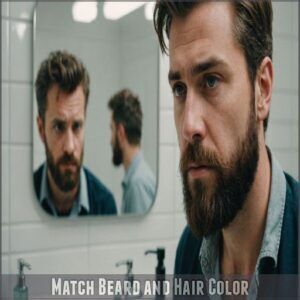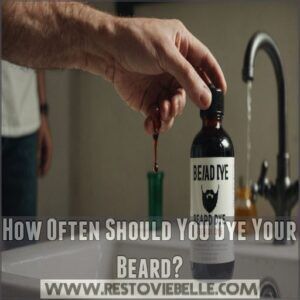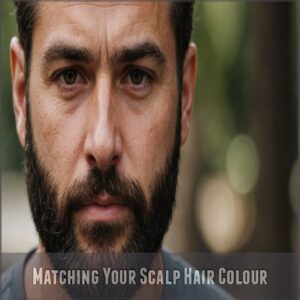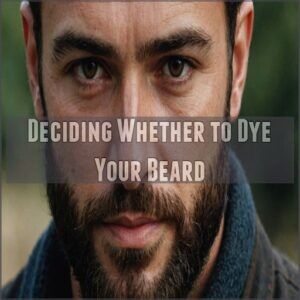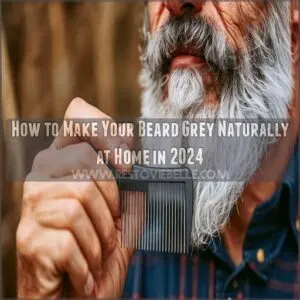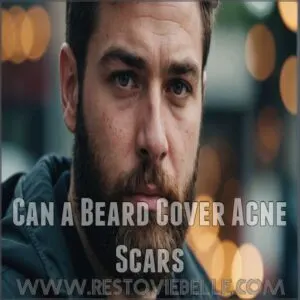This site is supported by our readers. We may earn a commission, at no cost to you, if you purchase through links.
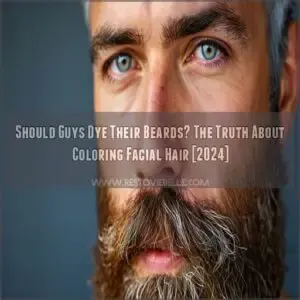 You’re not alone in wondering if you should dye your beard – it’s a game-changer for many guys.
You’re not alone in wondering if you should dye your beard – it’s a game-changer for many guys.
While beard dyeing can boost confidence and cover those pesky grays, it’s not a one-size-fits-all solution.
You’ll need to commit to regular maintenance every 4-6 weeks and be prepared for potential skin sensitivity.
The trick is finding the right product and shade that looks natural, not like you’re sporting a fake stick-on beard from a costume shop.
Whether you’re going for a distinguished salt-and-pepper look or total coverage, there’s a world of options beyond just reaching for the first box dye you see.
Table Of Contents
- Key Takeaways
- Why Do Guys Dye Their Beards?
- Pros of Dyeing Your Beard
- Cons of Dyeing Your Beard
- Will My Beard Still Look Natural?
- Can You Dye Your Beard if It’s Short?
- How Often Should You Dye Your Beard?
- How Can I Get Rid of Beard Dye if I Don’t Like It?
- Matching Your Scalp Hair Colour
- Not All Beard Dyes Are Created Equal
- Deciding Whether to Dye Your Beard
- Frequently Asked Questions (FAQs)
- Is it okay for men to dye their beard?
- Is dying a beard worth it?
- What are the disadvantages of beard dye?
- Should you dye your beard yes or no?
- What age is too young to dye beard?
- Can medication affect how beard dye takes?
- Does beard dye work on very light hair?
- Will chlorine or salt water affect beard dye?
- Can beard dye cause permanent skin discoloration?
- Conclusion
Key Takeaways
- Dyeing your beard can boost confidence and cover grays, but it requires regular maintenance every 2-3 weeks to keep the color looking fresh.
- Choose the right dye, considering your skin type and opting for hypoallergenic or natural products to avoid irritation.
- A well-chosen shade can provide a youthful look and enhance your self-esteem, but be cautious of a fake appearance by selecting a natural-looking color.
- Weigh the pros and cons, like potential hair damage and the maintenance time commitment, before deciding if dyeing is right for you.
Why Do Guys Dye Their Beards?
You’ve probably noticed those sneaky gray hairs creeping into your beard, or maybe you’re just ready to shake things up with a bold new look.
Whether you’re looking to cover up the signs of aging or create a statement-making style that turns heads, beard dyeing opens up a world of possibilities for transforming your facial hair game.
To Cover Up Gray Hairs
When those silver strands start showing up in your beard earlier than expected, it’s totally normal to think about covering them up.
Premature graying can hit your confidence, but beard dye offers a quick fix.
If you’re looking to color your beard at home, you can find a range of products on websites that specialize in beard dye for gray.
Here are three common reasons guys choose to cover their grays:
- Looking more youthful in professional settings
- Matching their head hair color
- Boosting self-confidence during dating
To Create a Bold Look
A bold beard color can completely transform your look.
You might want to try dyeing your beard if you’re into experimenting with unique styles or following the latest beard dye trends.
Whether you’re going for a striking blue-black shade or a rich auburn tone, dyeing your beard lets you express yourself.
It’s like giving your facial hair a makeover that matches your personality and style preferences.
To Stand Out
Standing out with a dyed beard lets you express your unique style.
Beyond creating bold looks, you’re making a statement about who you are.
Here’s why guys choose to shake things up with beard dye:
- It’s a chance to showcase your personality through unconventional colors
- You’ll break free from the usual grooming norms
- It helps create a signature look that people remember
- You can match your vibe with seasonal or trending colors
Pros of Dyeing Your Beard
You’ll be amazed at how beard dye can transform your look, from covering those pesky grays to matching your facial hair with your head hair for a more polished appearance.
Whether you’re looking to boost your confidence or create a more uniform beard color, dyeing your facial hair might be the game-changer you’ve been searching for.
Hide The Greys in Beard
Through the years, those pesky gray hairs can sneak into your beard, creating a salt-and-pepper look you mightn’t be ready for.
Here’s a quick comparison of different approaches to hiding grays:
| Method | Effectiveness | Maintenance |
|---|---|---|
| Natural Dyes | Gentle, gradual | Weekly touch-ups |
| Chemical Dyes | Immediate coverage | Monthly reapplication |
| Temporary Sprays | Quick fix | Daily touch-up needed |
You’ve got options that’ll help you maintain your signature look without compromising on beard health.
Provide a Youthful Look
Beyond hiding grays, beard dye can take years off your appearance.
Here’s how a fresh dye job helps you look younger:
- It restores your beard’s original, vibrant color from your younger days
- Darker facial hair creates sharper facial contours
- A uniform color eliminates the salt-and-pepper look that ages you
- The right shade can complement your skin tone, creating a more youthful glow
Plus, you’ll love catching your reflection and seeing that younger version of yourself looking back.
Confidence Boost
A fresh beard color can transform your self-esteem like a new suit or haircut.
You’ll catch yourself smiling more in mirrors and feeling ready to tackle anything.
Here’s what guys report after dyeing their beards:
| Confidence Area | Before Dyeing | After Dyeing | Impact Level |
|---|---|---|---|
| Social Events | Hesitant | Outgoing | High |
| Dating Scene | Reserved | Bold | High |
| Work Presence | Quiet | Assertive | Moderate |
| Self-Image | Uncertain | Assured | Very High |
Conceal Patchy Beard
A patchy beard can be a real confidence killer, but beard dye offers a clever fix.
When applied strategically, dye can create the illusion of fuller coverage by darkening lighter patches and evening out sparse areas.
By addressing the root causes of patchiness, such as hormonal imbalances and poor circulation, you can also stimulate new growth through methods like minoxidil treatment to further enhance the effectiveness of dye.
You’ll want to choose a shade that matches your natural beard color and apply it carefully to those thinner spots.
It’s like filling in the gaps of a puzzle.
Match Beard and Hair Color
Having a beard that matches your hair color creates a polished, put-together look.
When your facial hair and head hair are different shades, it can draw unwanted attention.
You can dye your beard to match your natural hair color or create a cohesive style that fits your personality.
- Feel confident knowing your look is intentional, not accidental
- Rock that perfectly matched appearance in photos
- Stop explaining why your beard is a different color
- Wake up every day looking exactly how you want
- Join the growing number of guys who’ve discovered this style secret
Cons of Dyeing Your Beard
While dyeing your beard might seem like a quick fix, you’ll want to weigh some not-so-fun downsides that could leave you scratching more than just your chin.
From the constant upkeep that’ll eat into your morning routine to the potential skin irritation that might make you look like you’ve had an awkward run-in with a poison ivy patch, there’s plenty to think about before you grab that dye bottle.
Possibility of Fake Appearance
While dyeing your beard can boost confidence, let’s talk about keeping it real.
You’ve probably spotted those guys with obviously dyed beards – it’s like they’re wearing a fake mustache from a costume shop.
Here’s what causes that artificial look:
| Common Mistake | How to Avoid |
|---|---|
| Too Dark Color | Go 1-2 shades lighter |
| Solid Block Color | Leave subtle variations |
| Sharp Edges | Blend the dye gradually |
| Matching Issues | Consider your skin tone |
It Can Damage Your Facial Hair
Chemical compounds in beard dyes can wreak havoc on your facial hair.
Regular dyeing strips your beard’s natural oils, leaving it brittle and prone to breakage.
You might notice your once-soft beard feeling like straw, especially if you’re using harsh dyes.
Plus, skin irritation and allergic reactions are common complications that can damage your hair follicles, leading to thinner, weaker beard growth.
Time and Effort
Beyond potential hair damage, beard dyeing isn’t a one-and-done deal.
You’re looking at a regular commitment that’ll eat into your schedule.
It’s like having a high-maintenance pet – you’ve got to keep up with it.
Here’s what you’re signing up for:
- Weekly touch-ups to handle new growth
- Monthly full dye sessions to maintain color
- Daily color-safe washing routines to prevent fading
Staining Skin
During the dyeing process, your skin can end up looking like you’ve gotten into a paint fight.
The dye often leaves stubborn stains around your neckline and jawline that won’t budge for days.
You’ll want to apply petroleum jelly along your hairline as a barrier before starting.
Even with precautions, some dyes are notorious for leaving temporary marks that’ll have you sporting a technicolor neck.
Use Organic Ingredients to Avoid Allergic Reactions
Your beard deserves the gentlest care possible, especially when it comes to dyeing.
Organic ingredients like henna, indigo, and natural plant extracts offer a safer alternative to synthetic dyes.
These natural options greatly reduce the risk of allergic reactions and skin irritation.
While they might take longer to show results, your skin will thank you for choosing chemical-free dye options that work in harmony with your body.
Will My Beard Still Look Natural?
You’re probably wondering if your dyed beard will end up looking like a spray-painted fence, and it’s a valid concern that many guys share.
Whether you’ll achieve that natural look depends on several factors, including the dye quality, color choice, and application technique you use.
Getting a Uniform Colour
Getting a uniform beard color isn’t rocket science, but it takes some finesse.
Think of it like painting – you want even coverage without any patchy spots or weird streaks.
- Start with a patch test to check for skin reactions
- Choose a dye shade slightly lighter than your target color
- Apply the dye evenly from root to tip
- Use a tinting brush for precise application
- Let the dye sit for the full recommended time
These steps help create that natural, blended look you’re after.
Getting Rid of Grey Hairs
Those pesky gray hairs can make you feel older than your years.
Covering them up with dye isn’t just about vanity – it’s about feeling like yourself again.
You’ll want to choose a shade that matches your natural beard color for the most authentic look.
Regular touch-ups help maintain consistency, but don’t worry if some grays peek through – it adds character and keeps things looking natural.
Hair Damage
While fighting those grays is tempting, beard dye can be tough on your facial hair.
Chemical dyes often strip away natural oils, leaving your beard feeling like straw.
Regular dyeing can lead to breakage and split ends, making your once-luxurious beard look brittle and unhealthy.
Think of it like over-bleaching – too much chemical processing can weaken each strand over time.
Colours Not Matching Properly
When beard dyes clash with your natural color, it’s like wearing mismatched socks on your face.
You’ve got to nail the shade selection from the start.
Using a beard dye chart can help you pick the perfect shade, and there are many resources available online, such as the one found at beard dye products.
Your natural beard might’ve different tones throughout, making perfect matching tricky.
Test the dye on a small patch first, and consider going slightly lighter than your target color – it’s easier to darken than to lighten if needed.
Fake-looking Beard
A fake-looking beard can make you feel like you’re wearing a costume instead of rocking your natural style.
You’re not alone – many guys struggle with this common dyeing challenge.
Here’s what usually gives away a dyed beard:
- Using a color that’s too dark or intense – A professional beard dyeing can help you achieve a natural-looking finish with vibrant color, minimizing the risk of an unnatural, uniform look.
- Applying dye unevenly across your beard
- Ignoring your natural undertones
- Forgetting about gray blending
- Overdoing the coverage instead of keeping some variation
Can You Dye Your Beard if It’s Short?
You can dye your short beard, but you’ll need to be extra careful since the dye will have more contact with your skin.
You’ll want to use gentle, hypoallergenic dyes that won’t irritate your face while giving you the color change you’re looking for.
Hypoallergenic Beard Dyes
If you’re sporting a short beard, hypoallergenic beard dyes are your best bet for a safe coloring experience.
These specially formulated dyes work great for sensitive skin and help prevent those dreaded allergic reactions.
For extra peace of mind, consider shopping for hypoallergenic beard dyes that cater to sensitive skin.
Top brands like Just For Men Sensitive and Naturcolor offer gentle options that’ll give you the color you want without the worry.
Remember to patch test first, even with hypoallergenic products.
Avoiding Harsh Chemicals
Most chemical beard dyes contain harsh ingredients like ammonia and PPD that can irritate your skin.
You’ll want to opt for natural alternatives like henna, indigo, or plant-based dyes that are gentler on your facial hair and skin.
Look for products with organic ingredients and avoid anything with artificial fragrances.
Remember, your face deserves better than those harsh drugstore dyes.
Proper Application Technique
Through proper application technique, you can achieve natural-looking results when dyeing a short beard.
The key is treating it like an art project – precision matters more than speed.
Here’s your game plan:
- Start with clean, dry facial hair
- Mix the dye to a thick, yogurt-like consistency
- Apply using small, gentle strokes starting from the bottom
- Leave it on for exactly the recommended time – no shortcuts!
How Often Should You Dye Your Beard?
You’ll need to touch up your beard dye every 2-3 weeks, as those stubborn grays and natural regrowth start playing peek-a-boo with your fresh color.
If you’re aiming for that consistently polished look, you’ll want to mark your calendar for regular maintenance sessions, just like you’d schedule your favorite barber appointments.
Maintaining The Desired Look
Keeping your dyed beard looking sharp means staying on top of maintenance.
To avoid any potential risks associated with dyeing, such as skin irritation or allergic reactions, make sure to follow a beard dye safety guide.
You’ll want to refresh your color every 2-4 weeks, depending on how fast your hair grows and the dye you’re using.
Dark dyes typically need more frequent touch-ups than lighter shades.
Pro tip: mark your touch-up dates on your calendar – it’s easier than trying to remember when you last dyed it.
Fading and Regrowth
Beard dye doesn’t last forever – you’ll need to plan for touch-ups every 3-4 weeks as the color starts to fade and new growth comes in.
Your natural hair growth pattern plays a big role here.
Some guys might notice their roots showing after just two weeks, while others can stretch it to six.
The key is watching for that telltale line where your natural color meets the dye.
Proper Upkeep for a Healthy Beard
To keep your dyed beard looking fresh, stick to a consistent care routine.
Use beard wash every other day to prevent color stripping, and apply beard oil daily to maintain moisture.
A weekly deep conditioning treatment helps combat dye damage.
When you notice roots showing (usually every 2-3 weeks), it’s time for a touch-up.
Remember, less frequent dyeing means healthier facial hair.
How Can I Get Rid of Beard Dye if I Don’t Like It?
If you’ve had second thoughts about your newly dyed beard, don’t worry – you’re not stuck with it forever.
You’ve got several options to remove the dye, from simple at-home solutions to professional treatments that’ll help you get back to your natural look.
Baking Soda and Water
When your dyed beard isn’t quite what you hoped for, baking soda can be your DIY rescue.
Mix equal parts baking soda and warm water into a paste for a gentle way to fade that color.
Here’s how to do it:
- Create a thick paste consistency
- Apply gently to your beard
- Let it sit for 5-10 minutes
- Rinse thoroughly with lukewarm water
Always do a patch test first to avoid any skin irritation.
Beard Shampoo
If baking soda didn’t do the trick, you’ll find beard shampoo is your next best bet for removing unwanted dye.
Let’s look at how different types stack up:
| Brand Type | Effectiveness | Time to Results |
|---|---|---|
| Natural | Gentle | 3-4 washes |
| Color-specific | Moderate | 2-3 washes |
| Chemical-based | Strong | 1-2 washes |
| Clarifying | Very strong | 1 wash |
| Specialty | Maximum | 1 wash |
Your regular face wash won’t cut it here – you’ll need a specialized beard shampoo designed to strip color.
Professional Help
Professional stylists can be your best friends when beard dye goes wrong.
While DIY methods work well, sometimes you need an expert’s touch to fix a dye disaster.
Here’s what a pro can offer:
- Advanced color correction techniques you won’t find in YouTube tutorials
- Safe chemical treatments that won’t damage your beard
- Personalized advice for maintaining your beard’s health post-treatment
Going pro might cost more, but it beats walking around with a botched dye job.
Matching Your Scalp Hair Colour
You’ll want your beard to match your scalp hair for that put-together look, but getting it right isn’t always a walk in the park.
If you’re planning to dye both your beard and head hair, you’ll need to pick colors that work together while avoiding harsh chemicals that could irritate your skin.
Achieving a Uniform Colour
Getting your beard to match your hair color perfectly takes some trial and error.
You’ll want to pick a dye shade slightly lighter than your hair since beards often appear darker when dyed.
Mix different shades to create a natural blend, especially if you’re working with salt-and-pepper coloring.
Start with a test patch to see how the color develops – it’s easier to go darker than to fix a too-dark dye job.
Avoiding Damage to Your Scalp
Protecting your scalp during the beard dyeing process is just as important as getting that perfect color match.
You’ll want to create a barrier between your skin and the dye to prevent irritation and potential damage, as some hair dyes contain allergens like paraphenylenediamine (PPD) that can cause scalp irritation reactions.
Apply petroleum jelly along your hairline and behind your ears to create a protective barrier.
Keep the dye strictly on your facial hair, avoiding scalp contact.
Test a small patch of skin first to check for sensitivity.
Choosing The Right Dye
If you’re trying to match your beard and hair color, you’ll want to choose a dye that’s slightly lighter than your target shade.
Your beard hair is typically more coarse than your scalp hair, so it’ll absorb color differently.
Look for dyes specifically made for facial hair – they’re gentler and give you better control.
Test a small patch first to make sure you’re happy with the results.
Not All Beard Dyes Are Created Equal
You’ll quickly notice that some beard dyes can transform your look while others might leave you looking like a botched art project.
When you’re shopping for beard dye, you’ll want to think about factors like permanence, ingredients, ease of application, and color range to find the perfect match for your facial hair goals.
Permanent or Temporary Solution
Now that you’re matching colors, let’s talk about your commitment level.
Beard dyes come in permanent and temporary options, each with its own perks.
Here’s what you need to know:
- Permanent dyes last 4-6 weeks and require touch-ups as your beard grows
- Semi-permanent options fade naturally over 2-3 weeks
- Temporary dyes wash out in 2-3 shampoos, perfect for trying new looks
Think about how often you’re willing to maintain your look before choosing your path.
Ingredients
After picking your dye type, let’s look at what’s actually in these products.
You’ll want to know exactly what you’re putting in your beard.
| Ingredient Type | Benefits | Watch Out For |
|---|---|---|
| Natural dyes | Gentle on skin | May fade faster |
| Plant-based | Chemical-free | Less color variety |
| Chemical dyes | Long-lasting | Potential irritation |
Look for dyes with natural oils and skip those with PPD if you’ve got sensitive skin.
How Easy is It to Apply?
Applying beard dye isn’t rocket science, but it’s not exactly a walk in the park either.
Different brands come with varying application methods – some need mixing, others are ready to go.
You’ll find squeeze bottles, brushes, or combs depending on the product.
The key? Follow the instructions closely and wear those gloves.
Think of it like painting – precision matters more than speed.
Colour Selection
Picking the right beard dye color isn’t just about matching your hair – it’s about finding what works with your skin tone and style.
Consider consulting a brand’s color chart, like the one offered by top beard dye brands, to guarantee accurate color selection and desired results as seen in the best beard dye options.
You’ll want to choose a shade that’s slightly lighter than your target color since dyes often develop darker.
Natural shades like warm browns and soft blacks typically look more convincing than stark colors.
Test patches are your best friend here – they’ll help avoid any color mishaps.
Deciding Whether to Dye Your Beard
If you’re on the fence about dyeing your beard, you’ll want to take a good look at your current grooming routine and skin sensitivity before taking the plunge.
You’ll need to commit to regular washing and moisturizing with beard oil, while keeping your skin type in mind to avoid any unwanted reactions from the dye.
Wash Your Beard
Before reaching for that dye, you’ll want to start with a clean canvas.
Regular washing removes dirt, oil, and dead skin cells that could interfere with the dye’s effectiveness.
Use a gentle beard shampoo 2-3 times a week, and don’t forget to exfoliate – it helps prevent ingrown hairs and makes sure the dye is absorbed evenly.
Think of it like prepping a wall before painting.
Moisturize With Beard Oil
Keep your beard moisturized with quality beard oil to protect those follicles before dyeing.
Regular oil application helps maintain your beard’s natural shine and prevents the dye from causing dryness or damage.
Mix a few drops between your palms and work it through your beard, focusing on the roots.
You’ll notice softer, more manageable facial hair that’s ready for coloring.
Consider Your Skin Type
Your skin type makes all the difference when choosing a beard dye.
If you’ve got sensitive skin, you’ll want to steer clear of harsh chemicals and opt for gentler, hypoallergenic options.
Always do a patch test behind your ear 24 hours before diving in.
Think of it like dating – you wouldn’t commit without getting to know someone first, right? Same goes for beard dye.
Frequently Asked Questions (FAQs)
Is it okay for men to dye their beard?
Dyeing your beard is perfectly fine and increasingly common.
Dyeing your beard is a personal choice, whether you’re covering grays, matching your hair color, or trying something new.
Just make sure you use quality products to avoid skin irritation.
Is dying a beard worth it?
Beard dyeing can boost confidence and fix patchy coloring, but it’s not for everyone.
Consider the maintenance, potential skin reactions, and whether you’re ready for regular touch-ups before making the commitment.
What are the disadvantages of beard dye?
The chemical compounds in the dye can irritate your skin and damage your hair.
You’ll need frequent touch-ups as it fades.
There’s always a risk of ending up with an unnatural look.
Should you dye your beard yes or no?
Whether you should dye your beard depends on your goals and concerns.
You’ll boost confidence with a fresh look, but consider potential skin irritation and maintenance requirements.
It’s your choice – just research proper techniques first.
What age is too young to dye beard?
You’re never too young to dye your beard, but it’s best to wait until you’ve got a full growth pattern – typically around 18-
Consider your reasons carefully and start with temporary dyes first.
Can medication affect how beard dye takes?
Several medications can impact how your beard absorbs dye, especially those affecting hair growth or hormones.
It’s best to check with your doctor before applying any new dye.
It’s best to do a patch test before applying any new dye.
Does beard dye work on very light hair?
Beard dye can effectively darken light-colored hair, but you’ll need a strong developer and color-matching expertise.
For best results, start with a shade slightly darker than your target color and do a patch test first.
Will chlorine or salt water affect beard dye?
Like a fickle friend, pool and ocean water can fade your dye faster than usual.
You’ll notice the color washing out quicker, so it’s smart to use a protective conditioner and reapply dye more frequently.
Can beard dye cause permanent skin discoloration?
Yes, you’re risking permanent skin stains if you’re not careful with beard dye.
While it’s usually temporary, some dyes can leave lasting marks, especially if you’ve got sensitive skin or use harsh chemicals.
Conclusion
Regarding answering "should guys dye their beards," there’s no universal answer that’ll change the world.
Your beard is uniquely yours, and whether you choose to dye it depends on your goals and lifestyle.
If you decide to take the plunge, start with a temporary dye to test the waters.
Remember, a well-maintained natural beard can look just as striking as a dyed one.
Whatever you choose, wear it with confidence – that’s what truly makes a beard stand out.



